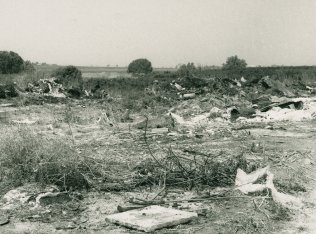| Year | Arab | Total |
|---|---|---|
| 1931 | 504 | |
| 1944/45 | 760 | 760 |
| Year | Arab | Jewish | Public | Total |
|---|---|---|---|---|
| 1944/45 | 11199 | 68 | 241 | 11508 |
| Use | Arab | Jewish | Public | Total | ||||||||||||||||||||
|---|---|---|---|---|---|---|---|---|---|---|---|---|---|---|---|---|---|---|---|---|---|---|---|---|
|
90 | 234 | 324 (3%) | |||||||||||||||||||||
|
11109 | 68 | 7 | 11184 (97%) |
The village stood on a low hill on the coastal plain. Wadi Marj passed along its southern perimeter. Secondary roads linked it to neighboring villages and to a highway that led to the city of al-Majdal, to the southwest. According to the inhabitants, Tall al-Turmus was founded over one hundred years ago. Its name apparently refers to the vegetation in the surrounding area; tall means "hill" in Arabic and turmus means "lupine" (a kind of herb).
Its residents, all of them Muslims, constructed their houses of adobe, building them first on the hill and later expanding the village site eastward and westward. The village had its own mosque. It shared a school with the village of Qastina, about 1.5 km to the northwest. Enrollment in the school reached 160 students in the mid-1940s. Agriculture represented the mainstay of the economy. The community cultivated grain, vegetables, and fruit. In 1944/45 a total of 154 dunums was devoted to citrus and bananas and 10,328 dunums were planted in cereals; 627 dunums were irrigated or used for orchards. Next to it lay a khirba with an ancient well.
As the first truce of the war was winding down, Israeli forces on the southern front were planning a major push south of Ramla towards the Negev, which they called Operation An-Far. Tall al-Turmus probably fell early in this operation, around 9–10 July 1948, to the First Battalion of the Giv'ati Brigade. During this operation, the villagers of Tall al-Turmus may have been among a minority who were driven over an Israeli-held strip towards Gaza, rather than eastwards towards Hebron.
The debris of the houses are strewn over the site and can be found near the clumps of cactuses and the sycamore and eucalyptus trees that grow there. The lands of the area are cultivated by Israeli farmers.
Related Content
Violence
End of First Truce: Israeli Operations An-Far, Dani and Qedem
1948
8 July 1948 - 17 July 1948

